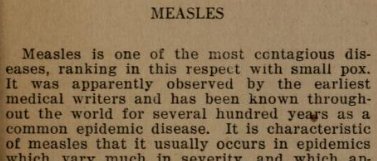I’m just a school teacher, I’m not a lawyer, and I certainly don’t give legal advice. However, as Studia Nova’s Head of Teachers I need to have a good grasp of the legal framework in California, particularly on hot-button issues.
It all began with the 2014 Disneyland measles outbreak. The measles is a highly contagious disease, and according to that Wiki Article, causes 2-3 deaths per 1,000 infected, and leaves at least one child with permanent brain damage. The math teacher in me can’t help this, let’s do it: 996/1000 children recover from the measles, so the current recovery rate of the measles is 99.6%. The recovery rate was not always so high as it is today. In 1775, the measles was introduced into the Hawaiian Islands, and in four months, 40,000 of the 150,000 population had died. According to George Weaver’s 1924 Book on Public Health, the measles had wiped out a quarter of a population. Today, the California Department of Public Health states that 73 cases of the measles were reported in 2019. The National Conference of State Legislatures, describes California as one of six states to remove the exemption, but was the leader of the pack.
The Disneyland measles outbreak drove the legislative process. By 2015, SB 277 was signed in to law by Governor Brown. The bill changed immunization law to eliminate the personal belief exemption for immunizations for all students accessing classroom-based education as well as attending day care centers.
There are exceptions, according to California Department of Education’s summary, Independent Study programs without classroom-based instruction and home-based private school (home-school) remained exempt from the immunization requirements. Additionally, because State law can not supersede Federal Law, and because special education is a federal requirement, under the Individuals with Disabilities Education Act (IDEA), SB 277 can not restrict access to class-room based instruction for students with documented learning conditions, such as an IEP that requires in-person instruction.
In recent years, we have seen a great expansion of Independent Study; there are so many more terrific options today than before. Studia Nova is totally dedicated to providing students a high quality Independent Study program. But as a teacher of many years, I can share with you that there is really no such thing as “on-line” learning. The core learning processes are exactly the same as they have always been for thousands of years. Students need to read, write, and do many math problems, the computers are just there to make this more efficient, and sometimes a just little bit more fun. There is only on-line curricula, not online learning, a subtle but important distinction.
Nevertheless, some learning programs have maladapted to technology, they have changed tried and true learning process because, well, computers. For example, multiple choice questions are a plague brought on by on-line programs that disproportionately harms our brightest students; those who are clever enough to guess at the answer without learning any new material.
Another bad idea is to ramp up the number of problems, because, well, teachers don’t have to grade the papers. In reality, more problems just means student fly through them as fast as they can to turn in the assignment, without taking the time to understand the big ideas.
And then there is the worst of the worst. Teaching young children in large video-conference classrooms, because, well, technology. It just doesn’t work. What is called synchronous learning, an on-line virtual class, is something that mature students can handle in limited quantities. But that is no way to teach our young ones. The only way to effectively help young students virtually is with one-in-one with on-demand virtual q/a sessions. The student is in control of the time, the student is engaged.
Studia Nova is dedicated to Independent Study that works for all ages.
